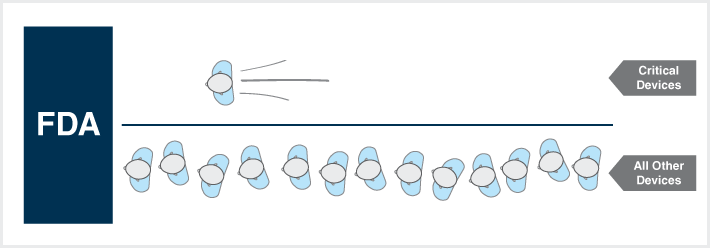FDA to Accept Applications for Expedited Medical Device Approval
/ in usability testing , user-centered design , design science , EAP , Expedited Access PMA , FDA , guidance , healthcare , human factors , industrial design , medical product design , news / by Christina SOn April 15th, the Food and Drug Administration will begin accepting applicants through its new Expedited Access Premarket Approval Application for Unmet Medical Needs for Life Threatening or Irreversibly Debilitating Diseases or Conditions (“Expedited Access PMA” or “EAP”).
What the EAP means for Med Device Developers
In a FDA news release issued almost a year ago to the day, the FDA explained that if a device qualifies for the Expedited Access PMA, the sponsor can, in effect, “cut the line” of companies waiting for FDA medical device approval.
What will the new submission process look like? The new pathway specifies that companies submitting a device that addresses unmet needs will receive more focused involvement with FDA senior management. This focused involvement is intended to facilitate earlier patient access to “high risk medical devices that are intended to treat or diagnose patients with serious conditions whose medical needs are unmet by current technology.”
The sponsor can, in effect, “cut the line” of companies waiting for FDA medical device approval.
Design Science Account Director Peter Sneeringer explains that the additional direction from senior management is sure to speed up the validation process because companies will have a much clearer idea of what the FDA wants to see.
“It’s hugely beneficial in terms of the understandability of what the FDA is looking for,” says Peter, who believes this guidance is going to be particularly useful for companies who are already in the process of designing this kind of diagnostic device.
Varun Saxena, a news editor for Fierce Life Sciences, predicts the EAP will bring the FDA’s validation process “more into line with its European counterpart, which regulatory [sic] approves critical devices years before the FDA.”
Understanding the Qualifications
How does a company know if their device qualifies? The FDA’s guidance includes three criteria and multiple examples to clarify eligibility for EAP designation.
-
“The device is intended to treat or diagnose a life-threatening or irreversibly debilitating disease or condition.”
The FDA lists chronic or active hepatitis, myocardial infarction (heart attack), cancer, and trauma as examples of life-threatening diseases. The guidance defines “irreversibly debilitating” as a condition “associated with morbidity that has substantial impact on day-to-day functioning.”
-
“The device meets at least one of the following criteria for addressing an unmet need”: there’s no pre-existing alternate for the device, it utilizes a superior technology to what’s currently on the market and is in the patient’s best interest to make the device available as quickly as possible.
The FDA includes examples of what would qualify a device as having no pre-existing alternate, including a “first-of-a-kind Parkinson’s Disease testing device to differentiate symptoms from other diseases that may be less treatable.”
-
“The sponsor submits an acceptable draft Data Development Plan.”
To read the entire explanation of qualifications, as well as additional considerations, you can read the new guidance in full on the FDA’s website.
Share this entry
-
Share on Facebook
Share on Facebook
-
Share on Twitter
Share on Twitter
-
Share on Google+
Share on Google+
-
Share on Linkedin
Share on Linkedin
-
Share by Mail
Share by Mail











